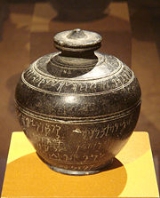
Bajaur casket
Encyclopedia

Bajaur
Bajaur or Bajur or Bajour is an Agency of the Federally Administered Tribal Areas of Pakistan. Smallest of the agencies in FATA, it has a hilly terrain. According to the 1998 census, the population was 595,227 but other more recent estimates it has grown to 757,000...
, in Gandhara
Gandhara
Gandhāra , is the name of an ancient kingdom , located in northern Pakistan and eastern Afghanistan. Gandhara was located mainly in the vale of Peshawar, the Potohar plateau and on the Kabul River...
. It is dated to around 5-6 CE. It proves the involvement of the Indo-Scythian kings of the Apraca
Apraca
Apraca, or Avaca, was an ancient Indo-Scythian kingdom or satrapy in the area of Bajaur in modern Pakistan from the 1st century BCE to the 1st century CE. Its rulers formed a small dynasty, called the Apracarajas...
, in particular King Indravarman, in Buddhism
Buddhism
Buddhism is a religion and philosophy encompassing a variety of traditions, beliefs and practices, largely based on teachings attributed to Siddhartha Gautama, commonly known as the Buddha . The Buddha lived and taught in the northeastern Indian subcontinent some time between the 6th and 4th...
. The casket is made of schist
Schist
The schists constitute a group of medium-grade metamorphic rocks, chiefly notable for the preponderance of lamellar minerals such as micas, chlorite, talc, hornblende, graphite, and others. Quartz often occurs in drawn-out grains to such an extent that a particular form called quartz schist is...
.
The inscription which is written in Kharoshthi, translates into English as:

